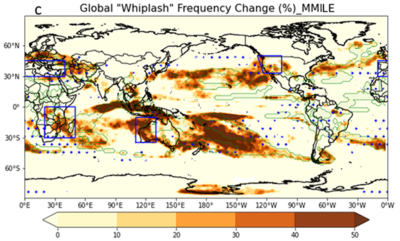Increasing Volatility of Precipitation Around the Globe
Precipitation "whiplash," defined as a swing from an extremely dry to an extremely wet year at some location, was studied across multiple global climate models, including 21st-Century projections. The atmospheric moisture budget was also analyzed to identify the physics associated with increases of whiplash.
This study identifies key regions, in particular those with Mediterranean climates, where extremely wet and dry years will become increasingly close together. These results imply that water resources will become increasingly unstable in the given regions, while drought, wildfires, flooding, and landslides are likely to become more common.
Throughout the world, the hydrologic cycle is projected to become more variable due to climate change, posing challenges in semi-arid regions with high water resource vulnerability. Precipitation whiplash results from hydrologic variability, and refers to interannual shifts between wet (⩾80th historical percentile) and dry (⩽20th historical percentile) years. Using five model large ensembles, we show that whiplash is projected to increase in frequency (25%–60%) and intensity (30%–100%) by 2100 across several semi-arid regions of the globe, including Western North America and the Mediterranean. These changes can be driven by increases in the frequency of wet years or dry years, or both, depending on the region. Moisture budget calculations in these regions illuminate the physical mechanisms behind increased whiplash. Thermodynamic changes generally dominate, with modulations by dynamics, evaporation, and eddies on regional or global scales. These findings highlight increasingly volatile hydrology in semi-arid regions as the 21st Century progresses.

